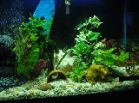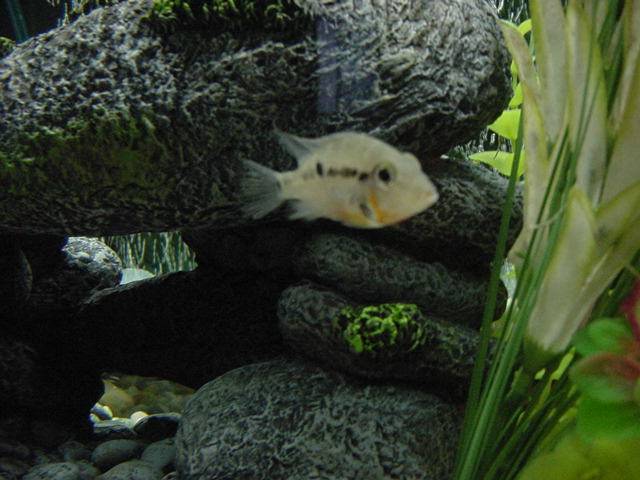|
|
|
Tank cycling

Tank cycling is something that every new aquarist has to do when
starting out with a new aquarium. It is easier to understand if you know
the basics and how it works.
Here at Personal Pet Advice we do not recommend cycling your tank
with fish. We recommend that you do a fishless cycle by adding fish
food to the tank to “feed” the tank and begin the process. Tank cycling
can be very stressful on your fish and can even lead to death.
Tank cycling takes approximately 4-8 weeks for it to fully cycle. In the
fishless cycling you will want to add a few pinches of fish food to the
tank twice a day and do water changes of 25% once a week. You need to
buy test strips so you can keep track of how the cycling is progressing.
These strips are inexpensive and can be purchased at the local fish store.
I prefer the 5in1 because they cover all the perimeters except ammonia.
You can purchase ammonia test strips and each perimeter that you want
to test for separately as well.
When you first test the perimeters of the water you
should find that the ammonia, nitrite, and nitrate levels
will all read 0 ppm. This is normal. As you begin
feeding the tank you will notice that the ammonia
readings will begin to rise. This is the first step in the
process. Food, fish poop, rotting plants and other debris in the tank will
produce ammonia therefore the water should be tested on a weekly basis
and if the fish for any reason just don’t seem to look or act right. Most
trouble begins with poor water quality.
There are three bacteria that are essential to your new tank. The first is
ammonia. It is the food for another important bacteria that feeds on the
ammonia causing it to break down and be less toxic to your fish. This
second bacteria is called Nitrite. Although it is important to the tank it
can also be very toxic and can lead to death. It is the waste of the Nitrite
called nitrate that is less toxic of the Nitorgen cycle that is the least toxic
unless it is found in very high levels of 40 ppm or greater. Anything over

this limit can be deadly but with frequent water changes these levels can
be kept at a minimal. For maintenance we recommend 25% on a weekly
basis. To make this task easier you can purchase a neat little gadget
called a Python. They make water changes easier no matter what the size
of your tank. It also has a gravel vacuum attached to clean the gravel.
After cleaning the water and gravel you can also use
the Python to refill the tank. Be sure the water
temperature varies no more than a few degrees.
After the ammonia has begun to develop you will
notice by testing the water that the nitrite levels are
beginning to rise. Once this bacteria appears then you know you are
almost finished. It usually takes a few days for the nitrates to appear
once the ammonia levels start to rise.
When the cycling is complete you will have 0 ppm readings for nitrite
and ammonia and somewhere less than 40 ppm for nitrates. It is then
safe to add fish. Only add a few fish to begin with. Every time you add
new fish there will be a rise in ammonia and your tank will need to do a
mini cycle to accommodate the extra bacteria being added to the tank.
Another note to keep in mind is the size of the fish. It is common for
beginners to add too many fish too soon. Try to resist the temptation. Be
sure to keep in mind that most pet stores keep juveniles in their tanks
and that since they are babies, they don’t stay that way for very long.
The rule of thumb is one inch of fish per one gallon of water. There are
always exceptions to this rule though and those being goldfish,
plecustomus and larger bodied fish as well as cichlids. A 10inch Oscar
has a bigger body mass than 10 neon tetras for example. The Oscar
could devour the tetras and only develop a slight bulge. Consider the
fishes mass when they are fully grown.
Now if you have already added the fish which most people do, you still
have to cycle the tank therefore you will still have to do the testing of the
water but you will need to test it every day, do more frequent water
changes as readings for ammonia of anything over .25 ppm is toxic.
Make sure you test after the water changes to make sure the levels are
once again safe for your fish. One myth is that the tank will not cycle

because the bacteria will not build up. This is just not true. A few years
ago I made the mistake of adding too many fish too soon. It took a book
that was written by David E Boruchowitz, editor of Tropical Fish
Hobbyist Magazine, author of hundreds of books, and a fish keeper for
almost 50 years, called “The Simple Guide to Freshwater Aquariums.”
He stressed how important water changes are especially during the
cycling process and after reading his books I have yet to have lost a fish.
The frequent water changes to keep the levels at a
lower reading do cause the cycling process to take a
little longer but in the long run it is much easier and
healthier for the fish.
Another note to keep in mind is you may also want to
only feed them once a day until after the cycling has
finished. Rule of thumb for feeding is look at the eye. This is the size of
the stomach. It is more deadly to overfeed than to underfeed.
I hope this information was helpful. I know it is a lot to absorb. If you
have any more questions, please feel free to ask. Asking questions and
doing research on the fish you would like to keep will save you money
in the long run along with the heartache of losing your fish.